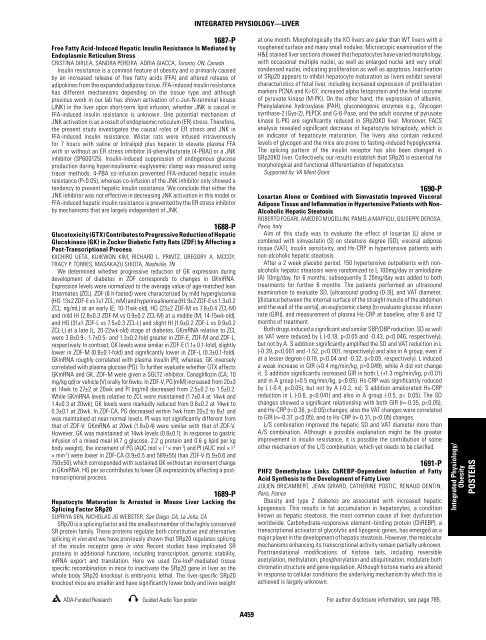2011 ADA Posters 1261-2041.indd - Diabetes
2011 ADA Posters 1261-2041.indd - Diabetes
2011 ADA Posters 1261-2041.indd - Diabetes
You also want an ePaper? Increase the reach of your titles
YUMPU automatically turns print PDFs into web optimized ePapers that Google loves.
1687-P<br />
Free Fatty Acid-Induced Hepatic Insulin Resistance Is Mediated by<br />
Endoplasmic Reticulum Stress<br />
CRISTINA DIRLEA, SANDRA PEREIRA, ADRIA GIACCA, Toronto, ON, Canada<br />
Insulin resistance is a common feature of obesity and is primarily caused<br />
by an increased release of free fatty acids (FFA) and altered release of<br />
adipokines from the expanded adipose tissue. FFA-induced insulin resistance<br />
has different mechanisms depending on the tissue type and although<br />
previous work in our lab has shown activation of c-Jun-N-terminal kinase<br />
(JNK) in the liver upon short-term lipid infusion, whether JNK is causal in<br />
FFA-induced insulin resistance is unknown. One potential mechanism of<br />
JNK activation is as a result of endoplasmic reticulum (ER) stress. Therefore,<br />
the present study investigates the causal roles of ER stress and JNK in<br />
FFA-induced insulin resistance. Wistar rats were infused intravenously<br />
for 7 hours with saline or Intralipid plus heparin to elevate plasma FFA<br />
with or without an ER stress inhibitor (4-phenylbutyrate (4-PBA)) or a JNK<br />
inhibitor (SP600125). Insulin-induced suppression of endogenous glucose<br />
production during hyperinsulinemic-euglycemic clamp was measured using<br />
tracer methods. 4-PBA co-infusion prevented FFA-induced hepatic insulin<br />
resistance (P
















